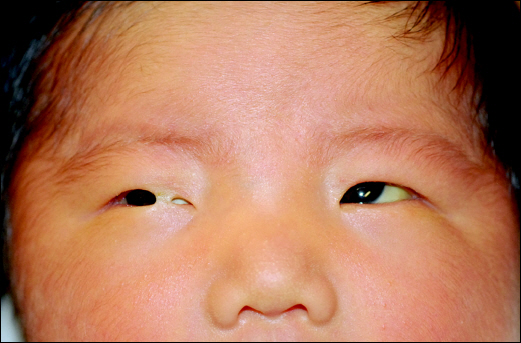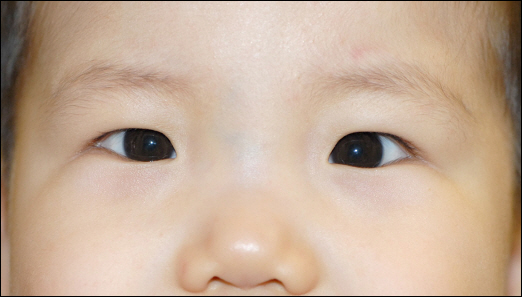J Korean Ophthalmol Soc.
2013 Apr;54(4):659-661. 10.3341/jkos.2013.54.4.659.
Ankyloblepharon Filiforme Adnatum : a Case Report
- Affiliations
-
- 1Department of Ophthalmology, Samsung Medical Center, Sungkyunkwan University School of Medicine, Seoul, Korea. ydkimoph@skku.edu
- 2Department of Ophthalmology, Sanggye Paik Hospital, Inje University College of Medicine, Seoul, Korea.
- KMID: 2216950
- DOI: http://doi.org/10.3341/jkos.2013.54.4.659
Abstract
- PURPOSE
To report a case of ankyloblepharon filiforme adnatum in a newborn male.
CASE SUMMARY
A 4-day-old male was referred for fused right eyelids with unremarkable other pediatric examinations. Ocular examination under general anesthesia revealed partial fusion of his right upper and lower eyelids by a 4 mm-wide band of tissue which arose from the skin of the upper and lower eyelids. The adhesion was separated by sharp scissors and no other ocular abnormalities were revealed.
CONCLUSIONS
Ankyloblepharon filiforme adnatum is a rare congenital malformation. In this case, the band of tissue connecting the upper and lower eyelids arose not from the eyelid margin but from the eyelid skin, which is even rarer, thus supporting the theory that this condition is due to the fusion of eyelids at abnormal positions, and not due to problems during the separation of eyelids.
Keyword
MeSH Terms
Figure
Reference
-
References
1. Duke-Elder S. System of ophthlmolgy. London: Kimpton;3:1964. p. 869–71.2. Weiss AH, Riscile G, Kousseff BG. Ankyloblepharon filiforme adnatum. Am J Med Genet. 1992; 42:369–73.
Article3. Jain S, Atkinson AJ, Hopkisson B. Ankyloblepharon filiforme adnatum. Br J Ophthalmol. 1997; 81:708.
Article4. Clark DI, Patterson A. Ankyloblepharon filiforme adnatum in trisomy 18 (Edwards's syndrome). Br J Ophthalmol. 1985; 69:471–3.
Article5. Kazarian EL, Goldstein P. Ankyloblepharon filiforme adnatum with hydrocephalus, meningomyelocele, and imperforate anus. Am J Ophthalmol. 1977; 84:355–7.
Article6. Hay RJ, Wells RS. The syndrome of ankyloblepharon, ectodermal defects and cleft lip and palate: an autosomal dominant condition. Br J Dermatol. 1976; 94:277–89.
Article7. Scott MH, Richard JM, Farris BK. Ankyloblepharon filiforme adnatum associated with infantile glaucoma and iridogoniodysgenesis. J Pediatr Ophthalmol Strabismus. 1994; 31:93–5.
Article8. Judge H, Mott W, Gabriels J. Ankyloblepharon filiforme adnatum. Arch Ophthalmol. 1929; 2:702–8.
Article
- Full Text Links
- Actions
-
Cited
- CITED
-
- Close
- Share
- Similar articles
-
- A Case of Ankyloblepharon Filiforme Adnatum
- One Case of Binocular Ankyloblepharon Caused by Stevens-Johnson Syndrome
- Ankyloblepharon, Ectodermal Defects, and Cleft Lip and Palate Syndrome Associated with TP63 Gene Mutation
- AEC Syndrome Confirmed by Genetic Study in Neonate: A Case Report
- A Case of Ankyloblepharon-Ectodermal Defect-Cleft Lip and/or Palate (AEC) Syndrome with Missense Mutation in TP63 1657(th)




